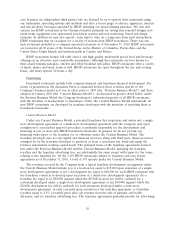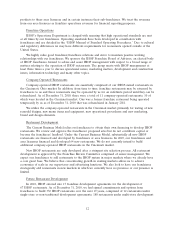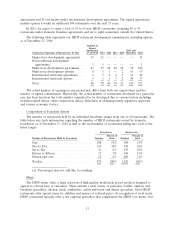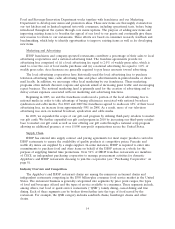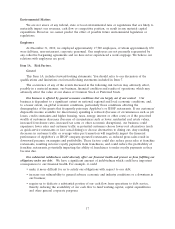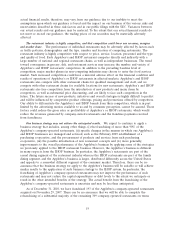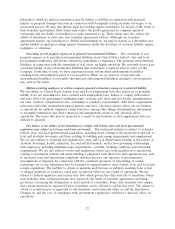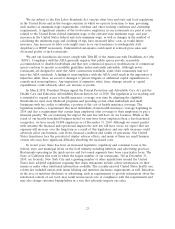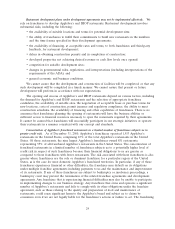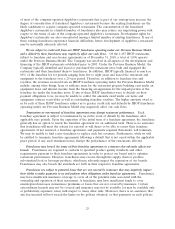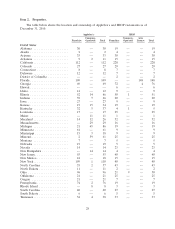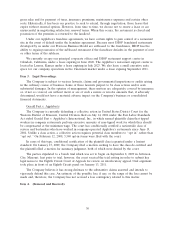IHOP 2010 Annual Report Download - page 36
Download and view the complete annual report
Please find page 36 of the 2010 IHOP annual report below. You can navigate through the pages in the report by either clicking on the pages listed below, or by using the keyword search tool below to find specific information within the annual report.that we and our creditors would consider desirable or within the anticipated time frame. On
October 11, 2010, we announced that we had entered into an asset purchase agreement for the sale of
36 company-operated Applebee’s restaurants located in the St. Louis, Missouri area and parts of
Illinois. The transaction closed in January 2011. On December 6, 2010, we announced that we had
entered into an asset purchase agreement for the sale of 30 company-operated Applebee’s restaurants
located in Washington D.C. and surrounding areas. The sale of 29 of these 30 restaurants closed in
February 2010. Following these transactions, Applebee’s is an 88% franchised system. The anticipated
proceeds from the refranchising of the company-operated restaurants are based on current market
values, recent comparable transaction valuations, and a number of other assumptions. The franchising
of Applebee’s company-operated restaurants is not expected to be completed for several years. If
market rents, comparable transaction valuations or other assumptions prove to be incorrect, the actual
proceeds from the franchising of the company-operated restaurants may be different than anticipated.
In addition, adverse economic, market or other conditions existing in the states in which company-
operated restaurants are located may adversely affect our ability to execute the franchising transactions
or to achieve the anticipated returns from such transactions. Market conditions may have changed at
the time the franchising transactions occur. Finally, the operational improvement initiatives or
purchasing initiatives may not be successful or achieve the desired results. In particular, there can be
no assurance that the existing franchisees or prospective new franchisees will respond favorably to such
initiatives.
Our performance is subject to risks associated with the restaurant industry. The sales and profitability
of our restaurants and, in turn, payments from our franchisees may be negatively impacted by a
number of factors, some of which are outside of our control. The most significant are:
• declines in comparable store sales growth rates due to: (i) failing to meet customers’
expectations for food quality and taste or to innovate new menu items to retain the existing
customer base and attract new customers; (ii) competitive intrusions in our markets;
(iii) opening new restaurants that cannibalize the sales of existing restaurants; (iv) failure of
national or local marketing to be effective; (v) weakening national, regional and local economic
conditions; and (vi) natural disasters or adverse weather conditions.
• negative trends in operating expenses such as: (i) increases in food costs including rising
commodity costs; (ii) increases in labor costs including increases mandated by minimum wage
and other employment laws, immigration reform, the potential impact of union organizing
efforts, increases due to tight labor market conditions and rising health care and workers
compensation costs; and (iii) increases in other operating costs including advertising, utilities,
lease-related expenses and credit card processing fees;
• the inability to open new restaurants that achieve and sustain acceptable sales volumes;
• the inability to increase menu pricing to offset increased operating expenses;
• failure to effectively manage further penetration into mature markets;
• negative trends in the availability of credit and in expenses such as interest rates and the cost of
construction materials that will affect our ability or our franchisees’ ability to maintain and
refurbish existing stores;
• the inability to manage a large number of restaurants due to unanticipated changes in executive
management, and availability of qualified restaurant management, staff and other personnel;
• the inability to operate effectively in new and/or highly competitive geographic regions or local
markets in which we or our franchisees have limited operating experience; and
• the inability to manage a large number of restaurants in diverse geographic areas with a
standardized operational and marketing approach.
20


